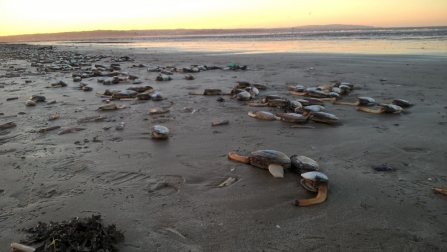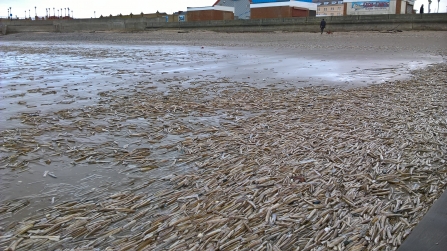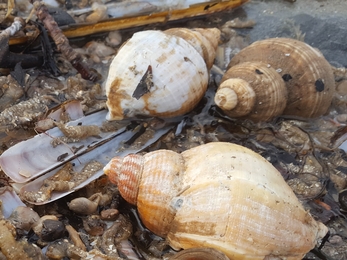What's stranding in your area?
Beached! aims to collect records of the species found washed up on our strandlines.
We’d like to build a baseline from the surprisingly different beaches across North Wales.
We’d also like to log seasonal comings and goings and especially collect records of those points in time when we have a “wreck” or even a “washout”, both names describing large dumpings of invertebrates (animals with no backbone) onto the beach, often after storms, but not always.
Why do we want to know about dead and empty stuff?
|
The Irish Sea is very productive and this is evident when looking at the strandline which is where the remains of animals and plants often end up after they have died. Looking at what ends up on the strandline helps us understand what is happening offshore. As well as building a solid baseline of information, Beached! hopes to answer two questions about our strandline: 1. Every now and then the strandline is dominated by large numbers of dead and dying animals of one or two invertebrate species. These are a common and, mostly, natural occurrence, as part of the cycle of life in our seas, but we know very little about where or why these ‘wrecks’ occur. A wider build-up of records might help provide a better idea of what could be the cause. We need to document these ‘wrecks’ of marine life to be able later to analyse things like the weather that occurred at the time. 2. Where are the best strandlines? Concentrations of shells and other things build up at certain spots. Are these always in the same place and are different species found at different times of year? |
Get involved with Beached!
This project would especially suit people who regularly walk a length of beach and want to know more about the sea offshore. Begin by paying attention to what's on your beach, where things tend to land or build up. You might find this changes across the year, or after certain types of weather, or during certain tide heights.
- Register for free with Cofnod (the North Wales record centre).
- Take a photo of the various species you want to record. If you’re recording a wreck, noting its approximate length (if possible a GPS location). Take a close-up photo of each individual species present.
- Go home and log in to Cofnod to record your finds. Using our guides (below) to give you an idea of the species or grouping.
- Your records will then be verified and added to the database.
Submit your Records
Please submit your records to us via the Cofnod Online Recording System.
If you are not registered on the Cofnod website, please fill in a registration form (this should only take a couple of minutes).
If you are already registered, log in then choose Enter Records Button and Beached!
Click here to email the Living Seas Project Officer for more information, if required.
Wreck or Remains?

How to distinguish a ‘wreck’ from a gradually formed concentration of remains
A ‘wreck’ has lots of dead and dying animals.
For example, most of the shells will have bodies in them.
There may be lots of gulls and crows feeding on them and after a day or so the scavengers may be so stuffed with food they just sit around digesting.

Gweddillion cyllyll fôr yn Y Rhyl ©Georgina Gittins
A concentration of remains usually contains only empty shells and is often a single species.
We are still interested in records of these concentrations, especially if they are a regular feature on your beach.
Here are some links to introductory videos of what you might find on shore.
Below you can find an introductory booklet and more in-depth PDFs of regularly wrecking species groups. Remember for certain groups there are additional webpages to help (see the link within the general strandline booklet).
Get to know how to ID some of our commonly wrecking species:

Shoresearch is part of Nature Counts a project funded by Welsh Government.
Beached! is part of Nature Counts, a project funded by Welsh Government.
















